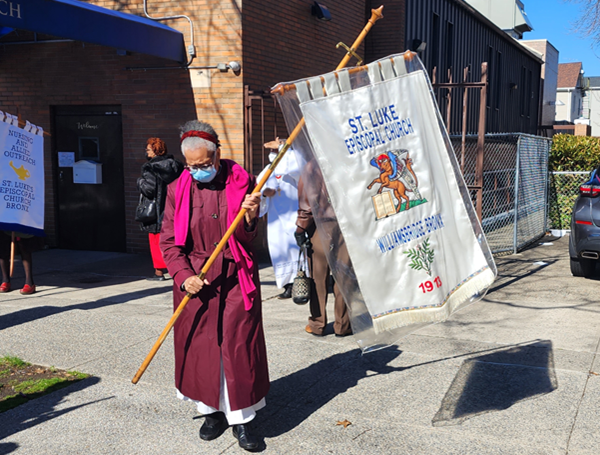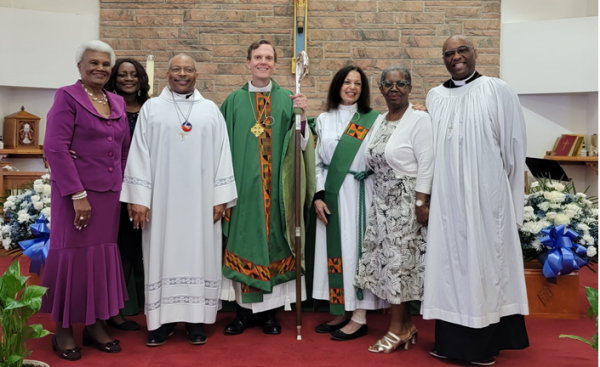Case Study
Cultivating a team of leaders brings deeper connection and commitment to a large city church.

St. Luke’s Church, the largest congregation in the Episcopal Diocese of New York, is a Black congregation with members from the Caribbean Islands, North and South America, and African countries such as Liberia, Ghana, and Nigeria. We are blessed with about 650 pledges from individuals or families. Our mission is to seek a deeper relationship with God through worship, prayer, and service to others, and we are strongly committed to outreach and the welfare of all God’s children.
 When I became the fifth rector of St. Luke’s in December 2012, the congregation was already known for its work in the diocese and the Caribbean, and for its partnerships with dioceses in Africa. Under my leadership, St. Luke’s has focused on incorporating our youth and laity into church ministry. The number of Eucharistic ministers and acolytes has grown from a handful to nearly 30. The arts, as a tool of worship, have found expression in liturgical dance, a children’s choir, and the resurgence of a contemporary gospel choir. Our feeding program serves over 4,000 meals per month and our food pantry distributes over 1,200 Food Pantry bags each month. Eight years ago, we held our first “Annual Police Appreciation Day” at our church. It is a day when police officers, parishioners, and community leaders gather to celebrate our oneness. An officer from housing from each borough, and officer from transit from each borough, and a police officer from each of the precincts of the Bronx and North Manhattan are recognized for services rendered to our city.
When I became the fifth rector of St. Luke’s in December 2012, the congregation was already known for its work in the diocese and the Caribbean, and for its partnerships with dioceses in Africa. Under my leadership, St. Luke’s has focused on incorporating our youth and laity into church ministry. The number of Eucharistic ministers and acolytes has grown from a handful to nearly 30. The arts, as a tool of worship, have found expression in liturgical dance, a children’s choir, and the resurgence of a contemporary gospel choir. Our feeding program serves over 4,000 meals per month and our food pantry distributes over 1,200 Food Pantry bags each month. Eight years ago, we held our first “Annual Police Appreciation Day” at our church. It is a day when police officers, parishioners, and community leaders gather to celebrate our oneness. An officer from housing from each borough, and officer from transit from each borough, and a police officer from each of the precincts of the Bronx and North Manhattan are recognized for services rendered to our city.
Ministry and mission can be overwhelming. Numbers 11 tells of a conversation in which Moses intimated to God how impossible it had become for him to carry out his ministry alone. Indeed, the burden of caring for a people so numerous was too heavy for Moses to bear. God instructed Moses to select seventy elders whom God intended to anoint to help Moses with the mission to which God had called Moses. Among many other things, this story calls our attention to the significance of team ministry. As the largest congregation in the diocese of New York, we at St. Luke’s understand that our clergy cannot fulfill our mission without the wholehearted participation of a large and effective lay leadership. We depend on the many talents that laypersons offer to God and neighbor through the ministry of our organization.
I spent the early part of my ministry getting to know parishioners, fostering and developing relationships with them and with community members. Through discernment and through spending time with our parishioners, I grew to identify potential leaders and their special gifts and talents. Consequently, I was able to invite them to serve in ministries that match their gifts and talents.
The writer of Ephesians 1: 15-17 provides some pointers for identifying and selecting leaders. Firstly, the writer pointed out the good in those whom he was addressing. Secondly, he let them know how thankful and appreciative he was of their ministry and stewardship. Finally, he reminded them that he was praying for them to continue to grow in the Lord. To these criteria, I would add a fourth: we need to offer training and provide feedback. When people are trained and provided with positive feedback, they feel supported to carry out the ministry to which they are called.
Ministry is never meant to be a one-person assignment. Numerous biblical passages and stories give evidence that effective and efficient ministry is carried out not by an individual but by a team.
 When I joined the ministry of St. Luke’s, I invited the vestry to envision how we could do ministry in a more transformational manner. Since the church owned several old buildings and empty lots, I proposed that we look into ways to use our gift of real estate to support the church’s ministry and mission. I then formed a housing task force (HTF) with one of the wardens in charge. Our HTF and I met with several firms and finally selected a developer to erect a new church building, 130 affordable housing units, a community health clinic, and a new space for our feeding program and community outreach ministries. We were scheduled to start construction in 2020 when the coronavirus changed everything. In 2022, we agreed to part ways with the developer and began to entertain new possibilities. Near the end of last year, we obtained a grant from Trinity Wall Street for a feasibility study on the housing project.
When I joined the ministry of St. Luke’s, I invited the vestry to envision how we could do ministry in a more transformational manner. Since the church owned several old buildings and empty lots, I proposed that we look into ways to use our gift of real estate to support the church’s ministry and mission. I then formed a housing task force (HTF) with one of the wardens in charge. Our HTF and I met with several firms and finally selected a developer to erect a new church building, 130 affordable housing units, a community health clinic, and a new space for our feeding program and community outreach ministries. We were scheduled to start construction in 2020 when the coronavirus changed everything. In 2022, we agreed to part ways with the developer and began to entertain new possibilities. Near the end of last year, we obtained a grant from Trinity Wall Street for a feasibility study on the housing project.
The raising of leaders for the HTF and other ministries has brought a deeper sense of connectedness among us, greater commitment, and stronger love and attachment to the church’s mission and ministry. The raising of leaders has taught us that church members are inclined to express greater appreciation and love for their church when their gifts are identified and used for the common good.
The Rev. Pierre-Andre Duvert was born in Haiti in 1964 and came to the United States in 1984. At an early age, he became involved in the youth groups of two different Episcopal churches and sang in the Choir of Holy Trinity Cathedral in Haiti. He always dreamed of entering the priesthood. In 1991 he was ordained at the Cathedral of St. John the Divine by Bishop Richard Grein. He is married to Elourdes, a dedicated church person, and they have three children, Herdrick Paul-Elie, Tina Lyse, and Derrick Pierre-Andre.